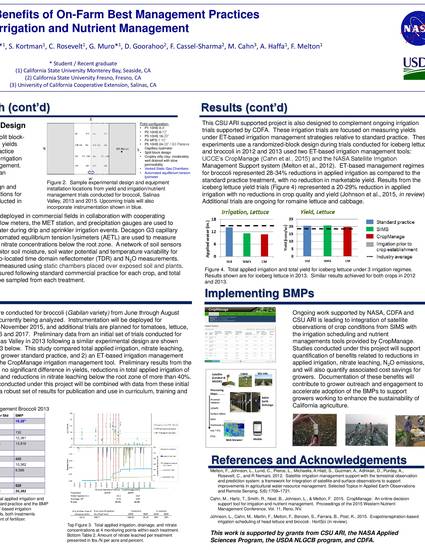
Presentation
Quantifying the Benefits of On-Farm Best Management Practices for Irrigation and Nutrient Management
AGU Fall 2017 Conference Proceedings
(2017)
Abstract
With the implementation of the Irrigated Lands Regulatory Program (INRP) in 2012 and the Sustainable Groundwater Management Act (SGMA) in 2014, growers across California are under increased regulatory pressure to meet nitrogen fertilizer and water use objectives through documented, measureable outcomes. Growers need information on the benefits of using low-cost best management practices (BMPs) so that they can quantify and report benefits of on-farm BMPs as part of an integrated irrigation and nutrient management strategy. This project will focus on conducting research to quantify the benefits of on-farm BMPs, including evapotranspiration-based irrigation management and the use of nitrate quick tests for fertilizer management. Leveraging ongoing irrigation and yield trials, the project is quantifying the benefits of these BMPs for increasing on-farm water use efficiency and reducing nitrate and nitrous oxide (N2O) losses from agricultural systems in the San Joaquin and Salinas Valleys. We are using a combination of automated equilibrium tension lysimeter (AETL) instruments, Latchat analysis methods, solute concentrations (Cl-, Br-) and soluble Rhodamine WT dye tracers, direct N2O flux measurements, gas chromatograph analysis, soil moisture sensor networks, flow meters, soil sampling, and micrometeorological techniques to quantity vadose zone total nitrate loads and N2O fluxes under different irrigation and nutrient management strategies. Initial studies in lettuce, broccoli, strawberries, and processing tomatoes will be used to document the benefits of these decision support tools and their associated cost savings. This project also provides a foundation for future research on additional crops and cropping systems, and for modeling of nutrient transport in the vadose zone.
Disciplines
Publication Date
December, 2017
Citation Information
I. Zaragoza, K. Post, L. Johnson, R. Spellenberg, et al.. "Quantifying the Benefits of On-Farm Best Management Practices for Irrigation and Nutrient Management" AGU Fall 2017 Conference Proceedings (2017) Available at: http://works.bepress.com/arlene-haffa/16/
